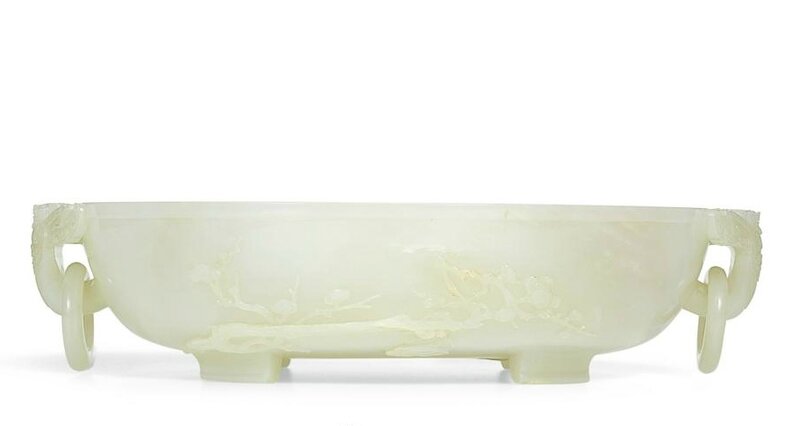Sotheby's. The Pilkington Collection of Chinese Art, Hong Kong, 06 Apr 2016
A superb and finely carved white jade marriage bowl, mark and period of Qianlong (1736-1795)
Lot 60. A superb and finely carved white jade marriage bowl, mark and period of Qianlong (1736-1795). Estimate HKD 2,500,000 — 3,500,000 (282,229 - 395,121 EUR). Lot Sold 6,080,000 HKD (686,381 EUR). Photo: Sotheby's.
with deep rounded sides supported on four splayed feet, rising to an everted rim flanked by a pair of loose ring handles suspending from two dragons, each skilfully rendered with outstretched wings decorated with archaistic scrolls and key-fret, the interior and exterior deftly carved on one side with a gnarled knotted branch of budding and flowering prunus, the underside incised with a four-character reign mark, the smoothly polished stone of a pale celadon-white tone streaked with icy inclusions; 24.8 cm, 9 3/4 in.
Provenance: Sotheby's London, 7th November 1961, lot 330 (£680), illustrated as the frontispiece of the catalogue.
Bluett & Sons Ltd, London, 1961 (£680).
Collection of Roger Pilkington (1928-69), from 1961 (£1150).
Note: Carved from a fine white boulder, the evenness of tone and translucency of which is highlighted in the broad plain surfaces, this marriage bowl is notable for its unusual shallow form and small, finely carved handles. The winged dragon forming these handles is one of the nine traditional representations of the dragon and is symbolic of imperial power. Notably, when viewed from the top the creatures' heads resemble a pair of butterflies flanking the vessel, a motif that was commonly incorporated on marriage bowls as a symbol of marital bliss.
Marriage bowls were popular during the Qing period and were often carved with a variety of auspicious motifs which offered blessings and good wishes upon a marital union. The blossoming prunus branch found on the interior of this piece represents renewal and strength of will as it flowers in the cold winter. Although not an emblem of longevity, the prunus tree is often associated with long life due to the fact that the flowers appear on the leafless and apparently lifeless branches of the tree until it reaches an extremely advanced age. Furthermore, the Daoist philosopher Laozi is said to have been born under this tree.
A wide variety of marriage bowls was produced with a large number of traditional auspicious motifs employed in the decoration. Examples with surfaces left similarly plain or only minimally carved, and flanked by winged dragon handles, include one of slightly smaller size, decorated with a spray of lingzhi, wannianqing flower and a cluster of berries, sold in these rooms, 8th April 2010, lot 1869; and another, the steep interior and exterior carved with swallows in flight among gnarled flowering camellia branches, published in Robert Kleiner, Chinese Jades from the Collection of Alan and Simone Hartman, Hong Kong, 1996, pl. 89, and sold at Christie’s London, 17th December 1981, lot 391, and again at Christie’s Hong Kong, 27th November 2007, lot 1522. Compare also a Qianlong mark and period marriage bowl, the interior carved with two swallows and a large spray of prunus, the exterior with scrolling Indian lotus and chilong-form handles, sold in our New York rooms, 19th March 2007, lot 614, the feet of this latter bowl are also positioned diagonally, similarly to the present piece, rather than at the front, back and sides, as is more commonly the case.

/https%3A%2F%2Fprofilepics.canalblog.com%2Fprofilepics%2F1%2F0%2F100183.jpg)
/https%3A%2F%2Fstorage.canalblog.com%2F03%2F02%2F119589%2F96711876_o.jpg)
/https%3A%2F%2Fstorage.canalblog.com%2F11%2F31%2F119589%2F94773502_o.jpg)
/https%3A%2F%2Fstorage.canalblog.com%2F20%2F83%2F119589%2F94772815_o.jpg)
/https%3A%2F%2Fstorage.canalblog.com%2F26%2F72%2F119589%2F75604929_o.jpg)
/https%3A%2F%2Fstorage.canalblog.com%2F59%2F60%2F119589%2F26458628_o.jpg)






/image%2F1371349%2F20240406%2Fob_a54acc_435229368-1644755382961141-18285727260.jpg)
/image%2F1371349%2F20240229%2Fob_b1ea4c_429582962-1625285201574826-43586635599.jpg)
/image%2F1371349%2F20240229%2Fob_84bc3b_429558450-1624783464958333-37673404077.jpg)
/http%3A%2F%2Fstorage.canalblog.com%2F36%2F88%2F119589%2F129555285_o.jpg)